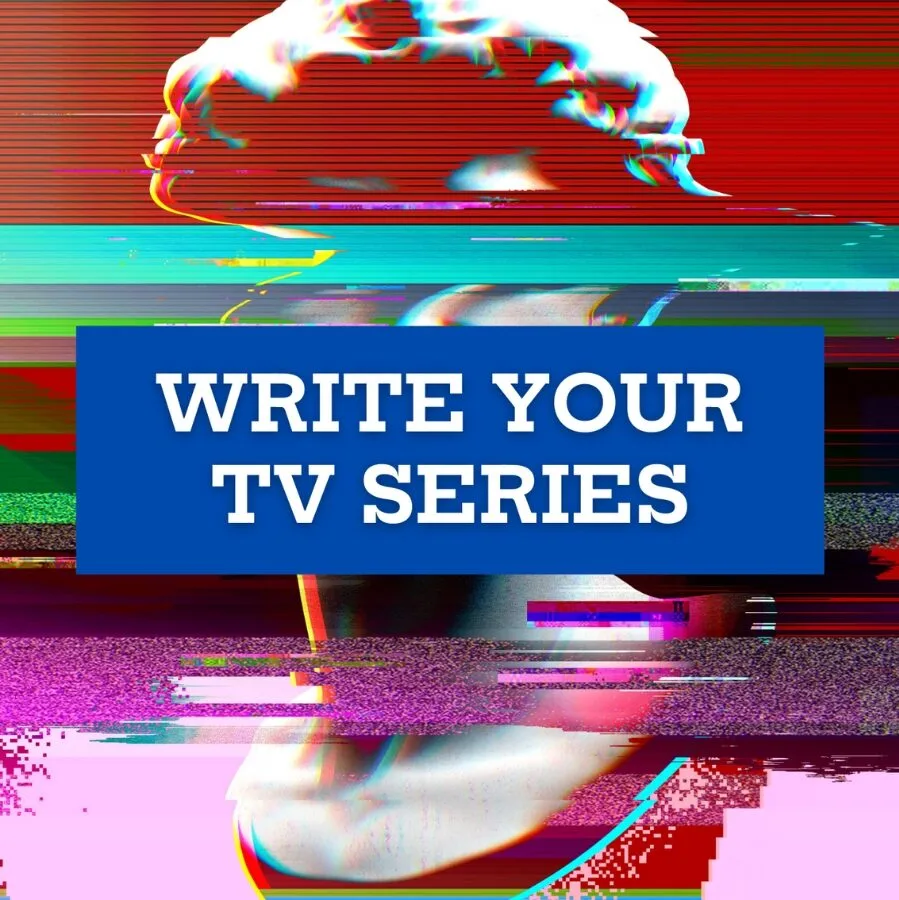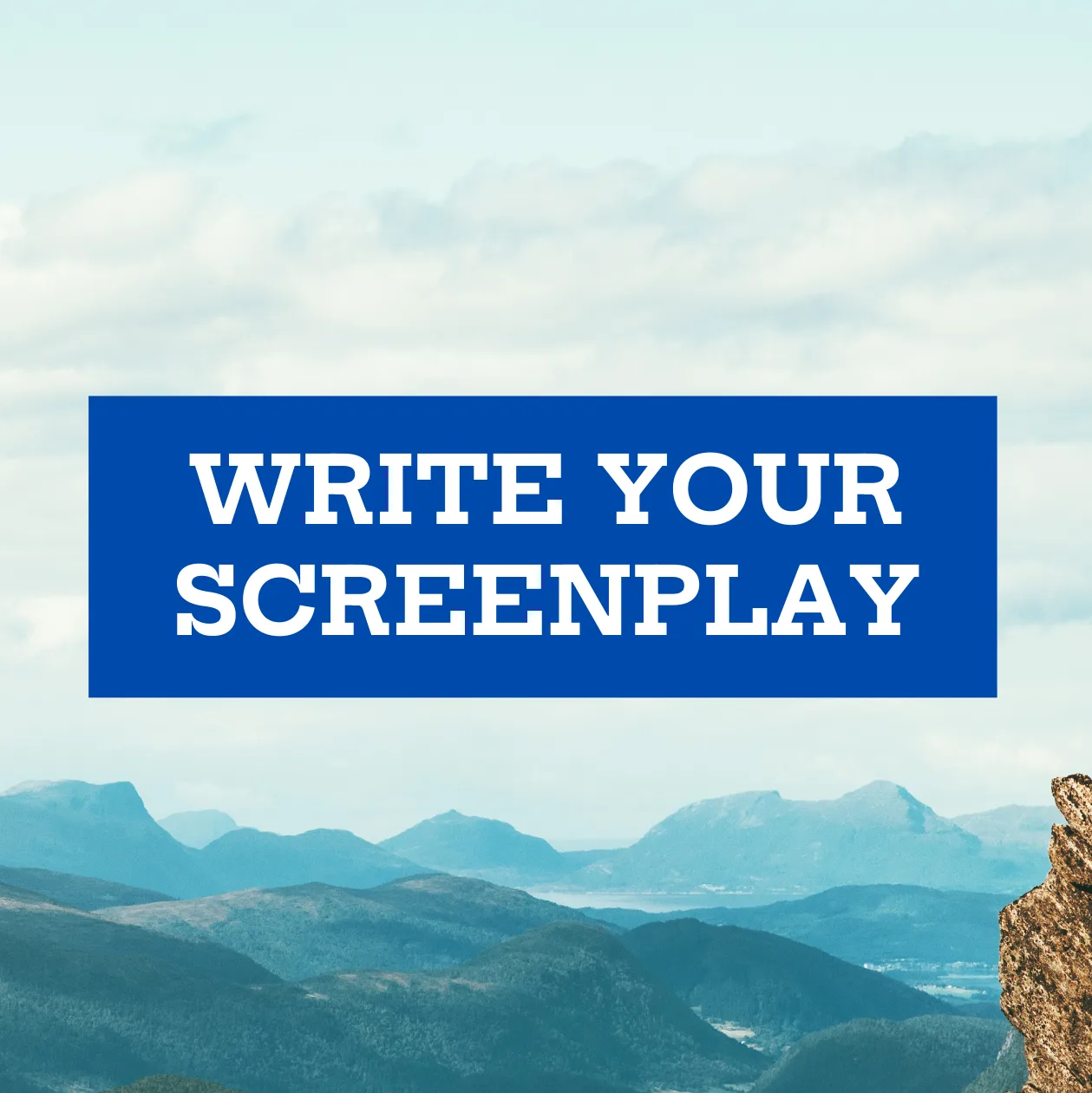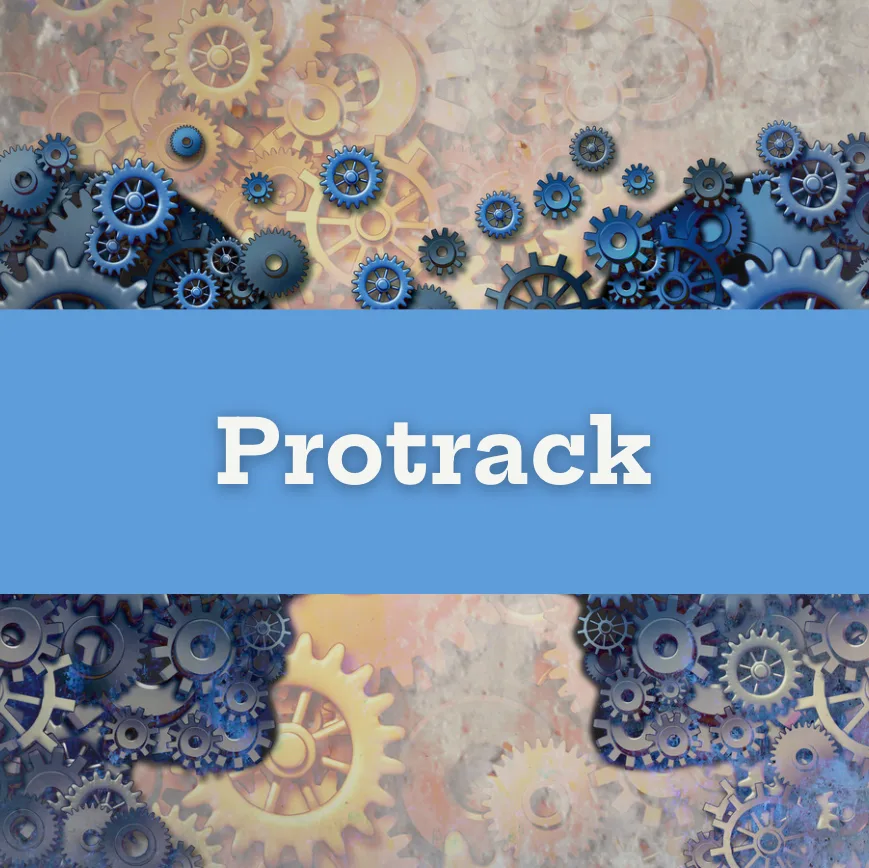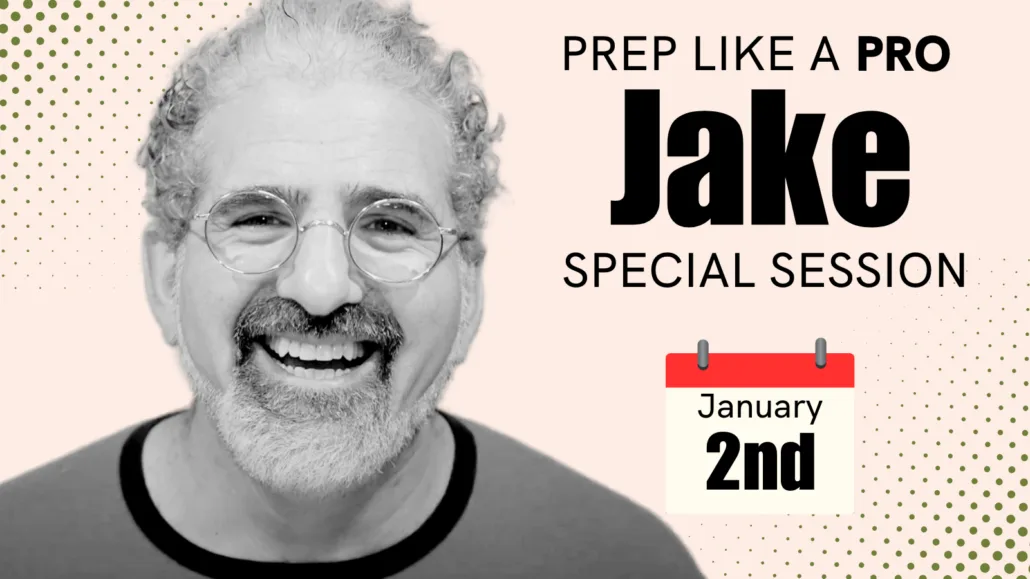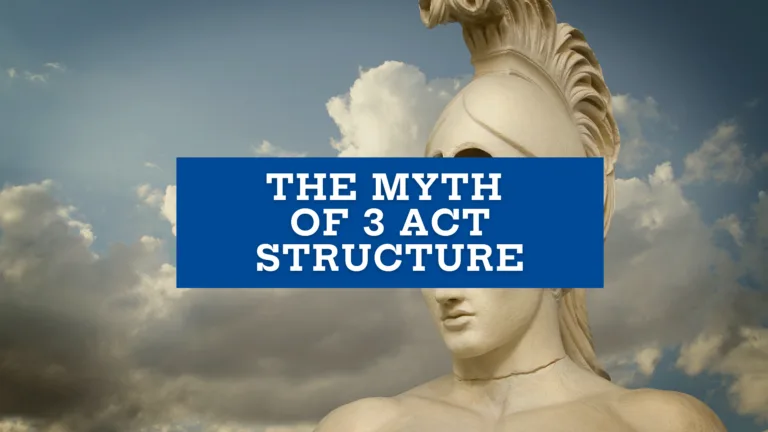Hello, I’m Jacob Krueger, and this is the Write Your Screenplay Podcast.
This week, we’re going to be talking about The Fall Guy by Drew Pearce. This is a remarkably silly movie based on the old, equally silly ’80s TV show.
At the center of the film are two scenes that we’re going to look at over the course of two podcast episodes. We’ll explore some interesting concepts you don’t expect to see in an action-comedy like The Fall Guy.
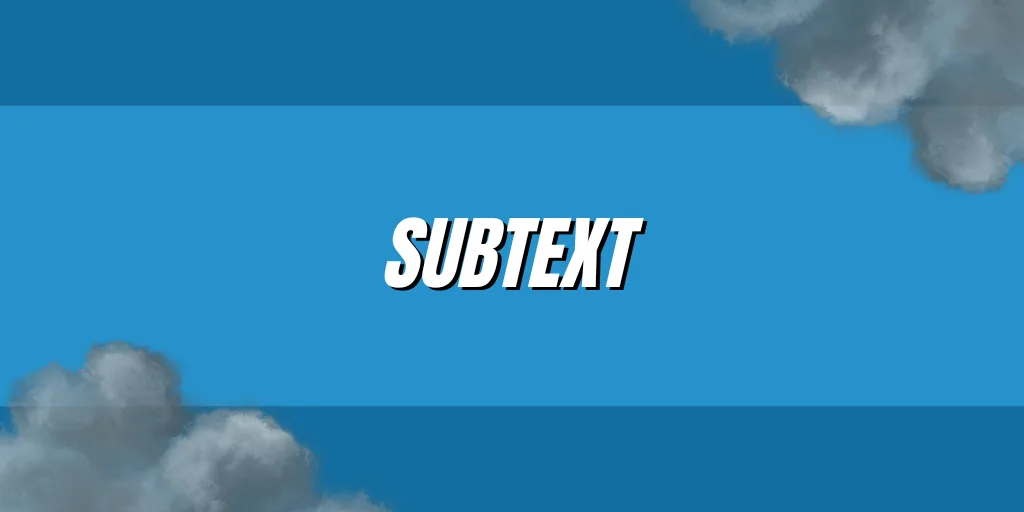
By analyzing two of the most successful scenes in The Fall Guy, we will learn about metafilm – how the movie comments on itself – and subtext – how to capture the unsaid intentions of your character in your dialogue.
We’ll also explore how The Fall Guy writer Drew Pearce grounds his scenes, chooses locations, and uses other techniques that can be valuable to your writing, whether you’re working on an action-comedy or something completely different.
You can feel pretty safe listening to this podcast even if you haven’t seen The Fall Guy yet. There are going to be very minor spoilers, but nothing you wouldn’t get from the trailer…
Let’s start by grounding ourselves in what The Fall Guy is actually about.
Ryan Gosling plays Colt Seavers, a top-of-the-line stuntman or “fall guy.” In many ways, the film is an homage to stuntmen – an underappreciated art form that makes so many movies possible. The film is directed by David Leitch, a former stunt performer. It’s jam-packed with fresh action, including a badass garbage truck chase scene and another sequence which broke the Guinness Record for most car cannon rolls.
If you’re a director interested in how to craft incredible action, it’s worth watching for that alone.
But we’re not going to talk about The Fall Guy just to discuss the action movie elements. We’re going to talk about something deeper.
One of the things that makes the script for The Fall Guy so successful is the relationship and the chemistry between Ryan Gosling and Emily Blunt’s characters: Colt Seavers and Jody Moreno.
Jody is a director longing for her shot at the big time when we first meet her. Colt is a top-shelf stuntman for the nastiest, most successful action movie star in the world: Tom Ryder, played by Aaron Taylor-Johnson.
Tom, of course, is an idiot, and Colt, of course, is a great guy. Jody and Colt, of course, are madly in love with each other.
But during the opening sequence, Colt suffers an injury that he blames on himself, shattering his self-confidence. During his recovery, he not only gives up on his career but also on Jody.
She wanted to show up for him and he wouldn’t allow her.
None of this is played for drama. It’s all played for comedy. This is not a movie designed to make you cry (or even feel). This is not a film designed to go deep. We’re not talking about Lars and the Real Girl here. It’s not a film that uses comedy to go deep into human emotion.
The Fall Guy is designed to make you laugh and be entertained by visual spectacle, some light self-criticism, and satire of the film industry. But that’s not really what allows us to connect to the film.
We’re not actually connecting to The Fall Guy because of the stunts, even though they’re a big part of the genre elements we came for. We’re connecting to The Fall Guy because we’re connecting to the characters.
We’re connecting to characters in The Fall Guy on two different levels: the way the characters are changing through the choices they’re making, which we call structure, and the emotional relationship between them, which we call hot relationships.
We process movies the same way we process life. You might think your life is about your job, ambitions, and goals. But what’s it really about? It’s about your relationships.
Your relationships define your life. The choices you make in relation to those relationships, and the choices you make on your own journey in relation to your own dreams are the structure and the hot relationships of your life. That’s what gives meaning to life and to movies.
Even if we’re playing on the surface, like Drew Pearce is doing at The Fall Guy, successful writers know it’s still those relationships that make a film successful.
So here’s the basic setup of The Fall Guy: Colt has given up on himself, his career, and the love of his life. He’s working as a valet when he gets a call from Gail, Tom Ryder’s producer.
Gail, played by Hannah Waddingham, is a satire of the typical Hollywood producer we all imagine. Gail tells Colt she needs him for an incredibly stupid sci-fi action epic that she and Tom are making called Metalstorm. Colt refuses – he’s had enough of the film industry and is doubting himself because of the accident.
So, the way Gail convinces Colt to show up is by telling him that this film is Jody’s first Hollywood feature and that Jody specifically requested him.
Because Jody asked for him, Colt decides to pick up his career and go.
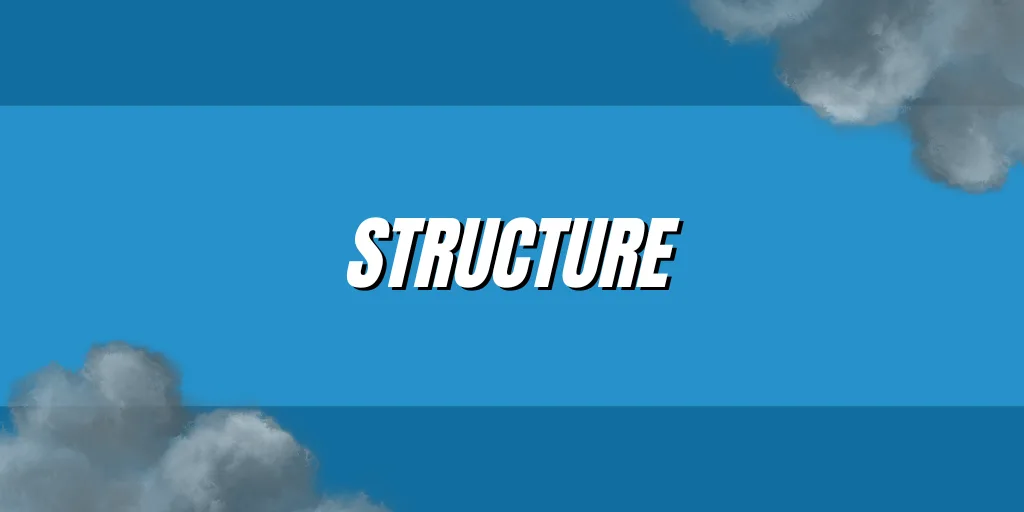
If we’re going to build structure, even in a silly movie like The Fall Guy, we need to build characters’ choices. Those choices happen in relation to the hot relationships, and in this case, the hot relationship is between Jody and Colt
At this point, we’re actually starting two different levels of action movie:
- The silly action movie, Metalstorm, that’s being filmed.
- An even sillier action movie – a “noir” mystery that Colt is going to get sucked into.
When Colt arrives on set, he finds out that Tom, the star, has disappeared. Now he needs to find Tom to save Jody’s movie. Gail doesn’t want to shake Jody’s confidence by letting her realize her star is missing. So, Jody can’t know.
To make matters worse, Colt quickly finds out that not only did Jody not, in fact, request him. Actually, there’s nothing Jody wants less than for Colt to be there.
But because of the issues with Tom (Jody doesn’t know they can’t find him, just that he’s throwing one of his fits and has disappeared), she’s stuck with Colt. She’s got to use him.
This leads to the first scene of The Fall Guy that we will be analyzing to learn about the fun ways that subtext and metafilm can be used, even in a mainstream Hollywood action comedy.
Let’s quickly define metafilm:
Metafilm is what happens when the film starts to comment on itself as a film.
Drew Pearce isn’t the first person to use this idea – it goes back to Shakespeare, who does meta-theater in A Midsummer Night’s Dream with Pyramus and Thisbe. This serves to both comment on what’s happening in the main play and to satirize his own play, Romeo and Juliet.
Pearce is using metafilm in two really interesting ways in The Fall Guy.
He’s using it for comedy, to allow the audience to feel like they’re in the know and make them feel smart.
He’s using it to deepen this ridiculously silly premise and, as we’ll talk about towards the end of this podcast, to poke fun at some of the silliness of his own movie.
Connected to the concept of metafilm, we have the concept of subtext. We don’t usually think of subtext as a metafilm concept, but as we’ll see from The Fall Guy they’re actually very similar.
With subtext, it seems like we’re having a conversation about one thing, but we’re actually having a conversation about something else, just like with metafilm.
At my recent Thursday Night Writes (and if you haven’t been coming to Thursday Night Write, what are you doing?! It’s a free class every Thursday where you can study with me and some of our most wonderful faculty members), I talked about the idea that anytime we have subtext, it’s happening simultaneously on multiple levels.
Even when we’re having a conversation that seems really direct, there are often levels of subtext happening underneath the surface that give that conversation its reality and meaning.
There are three levels on which subtext happens in dialogue.
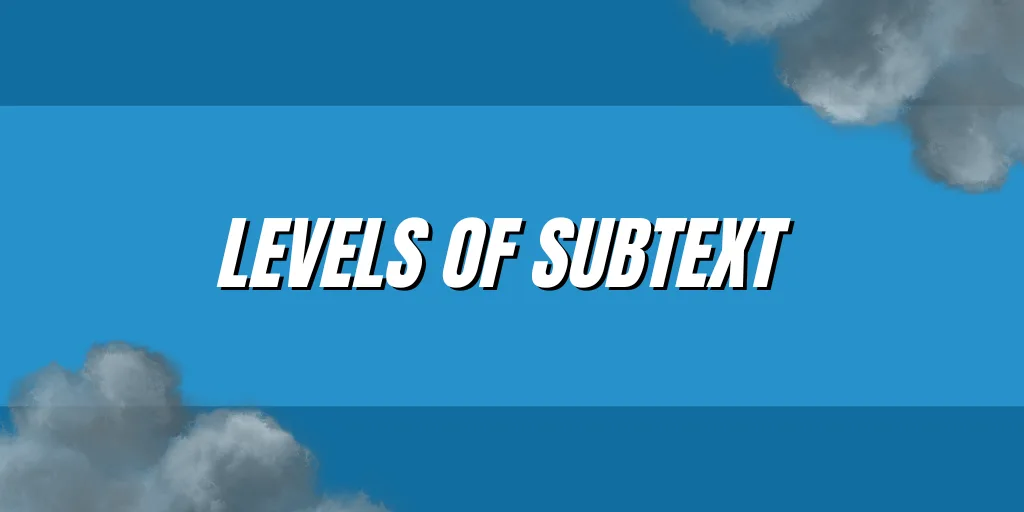
The first level of subtext is what is actually being said at both the textual level and subtextual level. What the character is trying to communicate. And the pressure, if any, between what’s on the surface of the actual text, and what, if anything, is being pushed down underneath.
For example, a character might say, “I really want a kiss,” and another character might respond, “Look, I am just hanging out with you because I’m trying to punish my ex-boyfriend.”
In this example, the characters’ communication is totally on the surface in the text. What they are thinking, and what they are feeling are both being communicated directly with words.
Or, the first character might say, “You look really nice in that dress.” But what he’s saying in subtext is, “I would like to kiss you.”
Or, if he’s nervous enough, he might push the subtext further down and say, “This is a really good gin and tonic.” But he’s actually talking about “I want to kiss you.”
Similarly, she might not respond, “I want to punish my boyfriend” in such a direct manner. She might push it down to the subtextual level, and let some other kind of text bubble up.
So when you’re thinking about this first level of subtext, you can ask yourself some questions about how the characters are communicating. Is what the character is thinking and feeling right there on the surface? Is it pushed down a little where it’s still obvious? Or is it pushed down a lot?
To what degree are the characters talking about directly what they mean versus not exactly what they mean– or are they saying something that seems even like the opposite of what they mean or maybe seems unrelated to what they mean?
The second level of subtext is what is being received and returned by each character.
Characters sometimes pick up subtext where there is none, miss subtext, receive intended or unintended subtext, or receive something the other character doesn’t even realize they’re sending.
I had a conversation recently over email. I’m looking for a new marketing director for our studio, so I’ve been interviewing people and I got a very impressive resume, so I emailed the person.
I said, “Could you please send along some portfolio items?”
And he sent me maybe 15 or 20 portfolio items. I was delighted.
So I emailed him back, “I’m going to take some time to review all this, and I’ll get back to you soon.” I was not trying to send subtext. I was actually trying to send text: “There’s a lot here. I’m excited to review it.”
But what he received, what he heard, was “I sent too much.” What he heard was, “Maybe this person is being sarcastic.”
And he sent me back a very clear textual response in which he said, “I don’t know you well enough to know whether you were being sarcastic, but I’m concerned that I might have sent too much. Would you like me to whittle it down for you?”
See what happened?
I said “Hey, I’m gonna review this,” I meant “Hey, I’m gonna review this,” but on a subtextual level what he heard was “This guy might be being sarcastic with me. I might have sent too much.”
That’s the second level: what is heard and what is returned.
And what is heard is not always what we say, because, as human beings, we are always speaking in code, sometimes even code that we keep from ourselves.
On the third level of subtext, there is what the great acting teacher Konstantin Stanislavski would call the Given Circumstances: Where is the character coming from? What just happened to them? And what stories are they telling themselves about that?
The reason that I consider that a level of subtext as well is because that affects both the way we communicate and the way we receive things.
If you want to play with subtext, it doesn’t matter which of these three doors you go through. They all lead to one another.
You can start with the story the character is telling themselves, what the character is receiving, or what the character is sharing. You can take the story or the belief, any of those, push it down or bring it to the surface. That’s how you can create great variation and levels of reality, meaning, and complexity in the way you use subtext in your own writing.
Let’s explore more deeply these three levels of subtext in relation to a scene in The Fall Guy.
We find ourselves about 21 minutes and 24 seconds into the film, in the middle of an action sequence for Metalstorm that Jody is shooting with Colt.
We get this silly effect with Colt set on fire, running towards the camera through the melee of aliens and humans fighting. Then he is flung back on fire into a rock.
On a textual level, this scene is Colt and Jody talking about the movie and what she needs for his performance. In her dialogue, Jody is technically giving Colt information about the character to “get the most” out of his stunt performance. But with her action (she keeps making him go through the stunt again and again) and with her subtext, it’s clear that this scene is not really about getting the shot for Metalstorm, but rather about Jody and Colt processing everything that’s happened prior.
This is the first level of subtext in the scene– the pressure between the dialogue on the surface, and what they’re really talking about underneath it. On the subtextual level, Jody’s not talking about the movie or the stunt. She’s talking about her relationship with Colt, her story about that, and how he broke her heart and owes her an explanation, by talking about the movie.
And on a meta-film level– the characters are talking about the movie inside of the movie, which is really just a commentary on their relationship.
Also happening on this first level of subtext is a desire that Jodi’s not expressing. She keeps on explaining why they need to shoot the scene again, “Oh, there was a little jitter there. We need to do this again. Maybe we need a line of dialogue.” And we keep watching Colt get set on fire and thrown against the rock.
On the surface, Jodi’s trying to “get the shot.” But what’s going on underneath is something much more complicated: She’s punishing Colt for what he did, and she is trying to get him to explain and apologize in a way that makes sense to her.
That’s not happening on the textual level until the very end, but it’s happening on the subtextual level, on that first level, throughout the scene.
On the Second Level of subtext, we have what’s being received and returned by the characters.
Despite the fact that Colt and Jody are ostensibly talking about Metalstorm, Colt, Jody, and everyone around them are both receiving and sending the real message. Everyone (including the audience) knows what Colt and Jody are talking about. And the fact that they fully understand each other not only makes the scene even more fun, but also helps build the connection between Colt and Jody– that these two get each other.
Part of the reason that we feel the chemistry between these characters is because they are both receiving each other’s unspoken messages. They are speaking, in metaphor, to each other.
And finally, on the third level of subtext, we have the Given Circumstances: the stories both characters are telling themselves about each other as they enter the scene, and the desires that grow out of these stories and influence both the dialogue and the action.
The story Jody is telling herself is that this guy broke her heart and then had the nerve to wheedle his way onto her set without her permission. This guy left her for no reason. Maybe it was just a fling, maybe she meant nothing to him, maybe she was just dumb and let herself fall in love with this guy who didn’t deserve it.
In Colt’s mind, there’s a story too: I tried to protect her. I didn’t want her to have to deal with what happened to me. That wasn’t fair. I was trying to be fair to her, but I messed it up, and I ended up losing something, but now she wants me back. No, she doesn’t want me back. What the hell is going on? What kind of game is being played here, and how am I gonna make it up to her?
Even though the characters are talking about Metalstorm, on both a meta-filmic and a subtextual level, all three levels of subtext are being communicated in their dialogue, not only to each other, but also to the audience.
We have all three of those levels of subtext happening, and then we have this cool meta-filmic container for the scene, which adds another layer of complexity, and comedy.
And finally, we have a really awesome location for the film.
This is a concept you should remember. It’s incredibly valuable. You are spending money when you choose a location. So choose a fun one!
A lot of writers would think, “Where do couples have a relationship conversation? Maybe in the bedroom. Maybe at dinner.” But the bedroom or dinner is one of the locations we always see these kinds of scenes happening.
Drew Pearce takes a scene that would traditionally take place in a domestic romantic setting and sets the location on the film set, in front of the whole crew and the extras who all stay active throughout the scene.
What’s so wonderful about this is, first off, it keeps us in that place of humor.
It also locks the characters into action, and it gives the characters something to talk about.
We find the subtext because they are on a movie set, not in the bedroom. We find the subtext because they can talk about location, the thing that’s going on in the location, rather than having to talk directly about their feelings.
So now we understand in a general way how three levels of subtext, a fourth level of meta-film, and a great choice about location come together to create a fun scene with tons of comedic and dramatic layers to it. So now let’s go beat by beat in our analysis:
We start off and we have this big action scene from a silly sci-fi movie.We see Colt appear on fire, running towards the camera. An explosion happens in front of him, he runs through the explosion and he’s blown back into the rock.
Then we hear Jody call “Cut, cut, cut!” and we see that we are on a film set. There is Colt getting fire extinguished by the crew. Suddenly we can see all the wires, we can see the extras in costume, we know where we are.
And if you remember my podcast about Beef, and the concept of game, you can see that the writer is starting to play a game: How many times can Jody throw this guy against this rock to punish him?
How are they gonna talk about the movie but really talk about themselves?
You can see the game connects the subtext and the metafilm that’s happening in this scene.
JODY: How you feeling Colt Seavers?
Here Colt gives his traditional thumbs up. Everything is always okay, and ultimately by the end of the movie, they’re going to process what does that thumbs up mean in a relationship, and how is that both what’s great about Colt, and also his problem that has cut him off from Jody.
JODY: We’re gonna go again. Thumbsup, okay?
They’re hitting that little thumbs up idea again, they’re getting it into your mind. And here it seems on a textual level, Jody just needs another shot.
JODY: Technical issue, little bump on the dolly.
Her words are about the shot. But her look tells us that something else is going on, as does the “Huh?” from the crew, allowing us, the audience to feel like there might be a little game starting here.
Next, Jody offers Colt some backstory through her megaphone. Again, on a textual level, if we weren’t smart, we might think maybe she’s just helping him as a director. But audiences are super smart when it comes to picking up subtext. So we’re delighted to realize: Oh, she’s playing a game with him.
And soon we’re going to find out what that game is, and we’re going to start to enjoy that. That’s the subtext, and that’s the beginning of the weaving of that subtext through a meta-filmic commentary within The Fall Guy.
JODY: So, sci fi love story, two characters, one of them’s an alien, Aliana, and you’re a Space Cowboy. They shared what’s called a moon season. In real life, you might call it a fling.
At this point, we realize that she’s not talking about Aliana and Space Cowboy. She is talking about herself and Colt. Also, at this moment, if we look at Ryan Gosling’s expression, we see him realize what’s happening for Colt.
On the first level, we have the text, “Let’s talk about the movie, what your character needs to know since you haven’t read the script.” And the subtext: we’re actually talking about you and I.
On the “what’s being received” level, Colt’s hearing exactly what Jodi’s actually saying, and he’s responding.
JODY: Now, neither of them had ever been in a relationship that deep before. And they told each other that over and over and over again. Him more than her, you know, to the point where sometimes she was like, “Chill out,” you know.
We’re watching his smile, his laugh, we’re watching him understand what she’s talking about. We’re also trying to understand what this means to her.
JODY: But anyway, in a tragic turn of events, Space Cowboy is wounded, and he just disappears.
And very quickly, we start to realize, “Oh, this is definitely about him.” And if you look at Ryan Gosling’s look, you see that land. You see him receive. You see the shame that he feels.
JODY: I could keep going
COLT: I can hit the rock better now.
This is another level of subtext. She’s saying, “Do you need me to say more?”
And even though he’s textually saying he’s prepared to perform the scene now, what he’s saying on a subtextual level is: I get it. And maybe even please stop.
In lesser hands, this scene is a boring, sad melodrama scene from a soap opera. “How could you just disappear on me like that?“
But by adding subtext and this little meta-filmic element, in The Fall Guy that melodrama is transformed into pure fun. And even though we’ve seen these kinds of betrayals before, we’ve not seen it exactly like this.
So Jody punishes him again. He’s set on fire, he runs through the explosion and he’s thrown against the rock and he’s fire extinguished. He gives the thumbs up.
But she’s not done. Instead of letting that be that, she continues:
JODY: For a little more context, Colt, Aliana’s got a nervous breakdown. And she starts sort of replaying everything in her head over and over again. Did she misread the vibe? Was it just a fling? Did she let her imagination run wild again? Or did he lie to her?
Jody starts to talk about all of Aliana’s feelings about what happened. She starts to get really deep about those feelings. And in getting really deep about those feelings, she takes the story she was telling herself coming into the scene, the Given Circumstances, and explicates it into the text.
That third level is now making its way to the first level. Was it just a fling to him? Did she just convince herself, again? Is this just a pattern that she’s in?
This is the story she’s telling herself, making it all the way up to the text level.
And we get this great shot of the alien extras shaking their heads. Because when you’ve got a great location, you keep it active, you make everything matter..
JODY: But let me be clear, eventually Aliana did move on, alright? And she started doing Pilates. Got herself a banging revenge body.
We get this great shot of the crew and the script supervisor looking at each other like, “What is she doing?!” They’re no longer even trying to have a veiled conversation. We’ve now moved from subtext to text.
We’re also getting this laugh, the idea of learning Pilates, that she’s got herself a hot body, and then she starts to punish him again:
JODY: And then she started dating other humans. One after another. And she had so many mindblowing, far superior experiences, you wouldn’t even believe it. Right, girls?
GIRLS: Yeah
JODY: Yeah, it was like a sushi train.
COLT: I’m gonna be sick.
Now we really understand the game. She’s gonna keep doing this to him. He gives her the thumbs up. He gets lit on fire, he runs to the explosion, he gets thrown back into the rock, he gets fire extinguished.
She’s gonna push the game to the next level. You can see this is exactly what we talked about when we discussed Beef: coming back to the same game again and again and again in different ways.
JODY: It’s just feeling so withheld, so how ‘bout some dialogue.
Darla looks at the script.
JODY: That’s alright, darling. I’m gonna go straight to the source. Hey, Colt, if Space Cowboy had to say something, if he was forced to say something, what would he say? How do you justify this year she spent spinning out over this? What could you say? It’s a puzzler, isn’t it? But have you got any thoughts? Uh, maybe he could talk… Nigel can you, can you get him a bullhorn? I can’t hear him”
Structurally, this is a shift in Jodi’s relationship with Colt. She’s done punishing him by throwing him against the rock. Now she wants an explanation.
It’s still the same game of we’re going to have to process what happened emotionally between the two of us by talking about the movie, but this character makes a new choice to escalate that game, by transitioning from punishing him physically and emotionally for what he did, to demanding an explanation.
To make it worse for him, she gives him a bullhorn so that he has to do it in front of all these people. And you can see again, this is the activation of the location where this scene takes place.
We get these little tiny moments that remind us: Hey, we are in a place. Let’s activate the place. Let’s make the place real. Let’s honor all the other characters there.”
By honoring all the other characters there and what they’re doing, Drew Pearce escalates the humor. But it also makes the piece feel more real. The scene is not just existing simply to facilitate the communication between these two characters. The scene existsbecause they are shooting a movie and everyone is behaving appropriately for what’s going on ,even as they’re in this uncomfortable situation between the director and the stunt guy.
COLT: In this movie, do the aliens and humans ever talk… in private?
What does Colt want here?
Colt wants to be able to have a private conversation with Jodi. The conversation we talked about earlier: Let’s discuss this at dinner. Let’s discuss this in the bedroom. Let’s discuss this somewhere where we’re not in front of an entire crew.
But he asks in a subtextual way. Up until now, he has just put up with being punished because he feels like he deserves it.
He’s tried to say, Hey, give me a break. I get it.
That didn’t work.
Now we’re escalating, and in a meta-filmic, subtextual way, he’s asking, “Hey, can we just do this in private? Do you not need to humiliate me in front of all these people?”
Again, that’s not what he says. He says, “In this movie, do the humans and the aliens ever communicate in private?”
But the message is heard, and the message is received.
JODY: No, not really. No, they don’t like doing private. They like to keep it very public. Very open.
COLT: I’d like to open up to the group here. Have you ever been in one of those situations where you want to say something and it’s so important that you can’t mess it up so you think long and hard about it, and then you realize you’ve already messed it up, ‘cause you thought too long and too hard about it?
What Colt does is Yes, and… Jodi’s game. Okay. Let’s open it to the group.
Instead of addressing her, he addresses the group. The subtext on the second level is received. On the textual level, he’s just asking a question, “Hey, have you guys ever felt like this?” On the subtextual level, he’s actually opening his heart.
He’s saying, This is what happened. I didn’t want to mess it up. And I just kept waiting and waiting and waiting. And now I’ve messed it up beyond repair.
Now here’s a wonderful little moment. The alien in the weird suit (who’s going to become important later in an action sequence), he’s active. He’s a character in this scene.
On the second level, unlike Colt, this alien character does not receive the subtext. He hears the textual question, “Hey, have any of you been in this situation?” So he asks for the bullhorn and he responds.
Now again, Drew Pearce activates the secondary character to amplify the humor: it’s going to be a joke:
ALIEN: [Feedback squeals, robotic voice] I had a similar situation when I fell in love with my wife’s sister.
We get a little joke there. And we get a different level of fun with the second level of subtext, showing us how wonderful it can be when a character doesn’t receive the same message the audience is picking up.
But all this grows simply from the writer remembering, there are other characters in this room and I have to honor their role in what is happening.
COLT: Ok, alright [feedback squeals]. Uh.. and again, this is hard because… you know, I haven’t read the script, but… he’d probably say… he’s been living in total regret since then. You know, afraid that he’ll never get an opportunity to make it up to her… because he waited too long.
The Fall Guy is designed to be silly and play on the surface. This movie is not designed to make you cry, and it’s not designed to be a melodrama. And the way Drew Pearce has built up to this line shows exactly how you can control tone in your writing.
Up until now, it has all been subtext, game, and jokes. But what we get on the other side of the humor is the actual emotion.
Colt now gets this one tiny moment where he gets to express his emotion in the text: he’s been living in regret ever since. And he’s afraid he’s never gonna be able to make it up to her.
This is the desire– to make it up to her– that ends up driving all of his actions in this movie.
Because of his desire to make it up to her, he’s gonna get sucked into a “noir” action mystery that is gonna put a little bit of pressure on his relationship with Jody.
He’s trying to make it up to her, and because he is trying to make it up to her, and because he’s the guy who always has to say “thumbs up,” he’s going to keep the truth from her.
So we get this little moment where he makes a new choice and actually makes himself vulnerable, in front of her and in front of everybody else.
Technically, this is still happening in meta-filmic subtext. Technically, they’re still talking about the script. But the real feelings have bubbled up almost all the way to the surface: Really, this is another level of vulnerability that is both sent and received and seen by everyone around.
And we see that result in the performance of Emily Blunt.
COLT: And… she’s probably moved on.
He expresses his fear that she’s probably moved on. At which point, the crew does what a crew does and goes, “Hey, talk about moving on, Jody. We really gotta move on.”
But Jody’s eyes are gonna linger on Colt.
JODY: One more?
COLT: I’d love another chance.
And we can see, this is the completion of the scene. This is Colt asking for what he’s wanted the whole time but has been afraid to ask for.
He’s asking for another chance. And she’s gotta decide if she’s gonna give it to him.
Every action movie is also a drama. Every comedy is also a drama. Every horror movie is also a drama.
Movies are about the emotional relationships between the characters, and those take place on the three different levels of subtext, on the textual level, on the “what’s being received and what’s not being received” level and on the “stories that the characters are telling themselves” level.
The action in the best action movies is just actually the conduit for the emotional relationships that are happening between the characters.
Yes, we have action genre elements. We have sci-fi elements, we have horror elements, we have comedy elements.
But whatever genre you’re working on, pyrotechnic elements are just the delivery mechanism for the thing that audiences come to movies for, which is relational drama and structure.
And this relates to your own writing as well.
On some level, all of our writing is metafilm.
Even if we’re writing something as silly as The Fall Guy, all writing is really us talking about our lives through the metaphor of other characters.
We might be talking about our lives vulnerably and emotionally with all the text right on top. Or we might be pushing the actual text down and using a silly or horrifying or expressionistic or historical story, but we’re always actually commenting on something personal that comes from us.
And that’s what it means to actually write your truth, to actually write what you know.
This brings part one of The Fall Guy Podcast to an end. But stay tuned for Part Two, in which we’re gonna be taking this idea up a notch, looking at a second scene that pushes the metafilmic elements of The Fall Guy and concepts of game and subtext even further…
If you’re enjoying this podcast, please support us. Write us a five-star review wherever you stream. You are what keeps this podcast going, and I’m so grateful for all of you.


